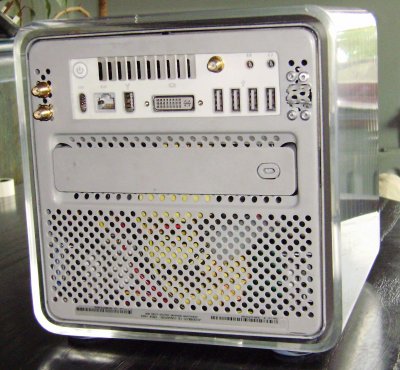- Joined
- Feb 11, 2012
- Messages
- 227
- Motherboard
- ASUS P8Z77-M Pro
- CPU
- i5-2500K OC @ 4.8 GHz
- Graphics
- HD 7750
- Mac
- Mobile Phone
So I just built my first Hackintosh in February - very boring.... NZXT H2 case, ga-z68a-d3h-b3 board, i5-2500k, Sapphire 6850, 16gb corsair blue ram, apple BT (salvaged from old MacBook) .... Basically a generic first Hack. I made use of this forum for a lot of help n getting Lion to work but all the piecing together was basic.
Now I find myself wanting to go a little further down the rabbit hole and make a G4 Cube Hack. I was hoping to get a little feedback guidance from some of you Cube Masters out there... Neilhart and mini hack come to mind. So here is what I have planned
Intel dh61ag board
i3 2105 or 2125 (I know neilhart will talk me into the 2125 for an extra 10 dollars)
8 gb Kingston 1333 memory 4gb x 2
Random laptop power brick
G4 Cube
Apple BT from my above hack as I never use BT on it
Apple wifi (ripped apart my first gen APple TV)
MBP SuperDrive
MBA 128 gb SSD (I have an adapter that lets it connect via SATA)
I think all of these should work well together, but if anyone has any concerns please voice them.
My real question comes on the case modding. As I am using the thin ITX board I would like to avoid cutting the original heat sink. Is this feasible? I would like to keep and use the original proximity power switch. Possible? I would like to do as little damage to the bottom panel as possible. Neilhart, how did you clean yours up so that there were no remnants of the original ports surrounding the LP I/O plate? Looks like some kind of resin or epoxy. Isn't possible to spray paint the bottom plate including the intel I/O plate to match the stock bottom plate look/color? I'm hoping to go fanless... Is this too ambitious? Finally, would appreciate some guidance on making board to mount my drives on.
Sorry for all the questions, but with all the combined knowledge on here, I figure it would be foolish to not take advantage. Thanks.
Now I find myself wanting to go a little further down the rabbit hole and make a G4 Cube Hack. I was hoping to get a little feedback guidance from some of you Cube Masters out there... Neilhart and mini hack come to mind. So here is what I have planned
Intel dh61ag board
i3 2105 or 2125 (I know neilhart will talk me into the 2125 for an extra 10 dollars)
8 gb Kingston 1333 memory 4gb x 2
Random laptop power brick
G4 Cube
Apple BT from my above hack as I never use BT on it
Apple wifi (ripped apart my first gen APple TV)
MBP SuperDrive
MBA 128 gb SSD (I have an adapter that lets it connect via SATA)
I think all of these should work well together, but if anyone has any concerns please voice them.
My real question comes on the case modding. As I am using the thin ITX board I would like to avoid cutting the original heat sink. Is this feasible? I would like to keep and use the original proximity power switch. Possible? I would like to do as little damage to the bottom panel as possible. Neilhart, how did you clean yours up so that there were no remnants of the original ports surrounding the LP I/O plate? Looks like some kind of resin or epoxy. Isn't possible to spray paint the bottom plate including the intel I/O plate to match the stock bottom plate look/color? I'm hoping to go fanless... Is this too ambitious? Finally, would appreciate some guidance on making board to mount my drives on.
Sorry for all the questions, but with all the combined knowledge on here, I figure it would be foolish to not take advantage. Thanks.





